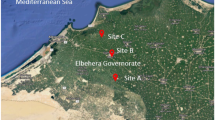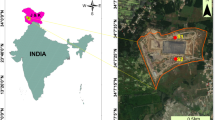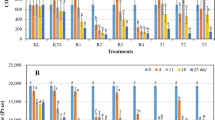Abstract
Landfill leachate is a potential environmental threat. Sanitary landfills are model sites which contains a leachate collection pool and a processing facility to treat it up to environmental standards before discharge. The present study is the very first endeavor to establish leachate treatment efficiency of indigenous microbial strain Brevibacillus agri. Leachate samples were inoculated with isolated strain and incubated for 41 days in an orbital shaker. Percent reduction in major water quality parameters was assessed after 0, 7, 21, and 41 days of incubation, for understanding the degradation kinetics. Results of the study demonstrate that Brevibacillus agri was effective in improving the wastewater quality of both raw and primary treated leachate. Overall reduction for different water quality parameters was found to be 50% higher for primary treated leachate than that for raw leachate within 21 days of incubation. Microbial degradation followed first-order kinetics with rate constants in the range of 0.0047–0.03 and 0.0061–0.074 day−1 for raw and primary treated leachate respectively. Calculated half-life of each pollutant parameter was significantly higher in the raw sample (23–147 days) as compared to the primary treated one (27–112 days). The leachate pollution index (LPI) value of the raw leachate was also found to be > 25% higher than primary treated leachate sample after microbial treatment. Hence, it can be concluded that on site application of primary treatment technology followed by secondary microbial degradation by indigenous microflora, viz., Brevibacillus sp., may prove effective to achieve desirable water quality for safe environmental discharge.

source: Thirteen International Waste Management and Landfill symposium, Proceedings Sardine, 2011[16])




Similar content being viewed by others
Data Availability
Data is available.
References
Vaverkova, M. D. (2019). Geosciences., 9(431), 1–16. https://doi.org/10.3390/geosciences9100431
MSW. (Management and Handling) rules. (2000). Ministry of Environment and Forests, India.
Ellouze, M., Aloui, F., & Sayadi, S. (2008). Journal of Hazardous Materials, 150, 642–648.
Castrillon, L., Fernández-Navaa, Y., Ulmanu, M., Anger, I., & Maranona, E. (2010). Waste Management, 30(2), 228–235.
Aziz, S. Q., Aziz, H. A., Yusoff, M. S., Bashir, A., Muhammad, M. J. K., & Umar, M. (2010). Journal of Environmental Management, 91, 2608–2614.
Rudianasari, A. S., Yohandri, B., Tresna, D., Achamad, J. S., & Susila, A. (2020). International Journal on Advance Science Engineering Information Technology, 1(10), 400–406.
Zineb, H., Latifa, M., Salah, S., & Laila, S. (2020). Journal of Health & Pollution, 10, 28.
Zhang, L., Lavagnolo, M. C., Bai, H., Pivato, A., Raga, R., & Yue, D. (2019). Resources, Conservation and Recycling, 141, 474–480. https://doi.org/10.1016/j.resconrec.2018.11.007
Jain, R., Garg, V., Singh, K. P., & Gupta, S. (2012). International Journal of Environmental Sciences, 3(2), 1841–1851.
Silva, A. C., Dezotti, M., & Jr Sant’Ann, G. L. (2004). Chemosphere, 55, 207–214.
APHA. (2012) Standard methods for examination of water and wastewater. 22nd edn. Washington D.C.
Ahmadian, M., Reshadat, S., Yousefi, N., Mirhossieni, S. H., Zare, M. R., Ghasemi, S. R., Gilan, N. R., Khamutian, R., & Fatehizadeh, A. (2013). J Environ Public Health, 3(5), 151–157. https://doi.org/10.12691/aees-3-5-5
Jain. R., Majumdar. D., Mondal. R., (2021) in Spatial modeling and assessment of environmental contaminants. In: Environmental Challenges and Solutions (pp. 29–53). Springer.
Krishnamurthi, S., & Chakrabarti, T. (2013). Systematic and Applied Microbiology, 36(1), 56–68.
Kumar, D., & Alappat, B. J. (2005). J Clean Technol Environ Pol, 7(3), 190–197.
Salami, et al. (2015). BJAST, 5(1), 48–59.
Afsar, S. S., Kumar, S., & Alam, P. (2015). International Journal of Advanced Technology in Engineering and Science, 3(1), 552–558.
Verma, M., & Kumar, N. K. (2017). Journal of Water Reuse and Desalination, 8(2), 234–243.
Rana, R., Ganguly, R., & Gupta, A. K. (2018). Environmental Monitoring and Assessment, 190, 46.
Dadrasnia, A., Usman, M. M., Wei, K. S. C., Velappan, R. D., Jamali, H., Mohebali, N., & Ismail, S. (2016). Proc Saf Environ Prot., 100, 264–271.
Dadrasnia, A., Azirun, M. S., & Ismail, S. B. (2017). BMC Biotechnology, 17, 85.
Ardeshir, R. A., Rastgar, S., Peyravi, M., Jahanshahi, M., & Rad, S. A. (2017). Environmental Technology, 38(19), 2447–2455. https://doi.org/10.1080/09593330.2016.1264488
Yang, Y., Xie, L., Tao, X., Hu, K., & Huang, S. (2017). PLoS ONE, 12(707), e0178837.
Zhang, D., Vahala, R., Wang, Y., & Smets, B. F. (2016). International Biodeterioration and Biodegradation, 113, 88–96.
Alvarez, P. J. J., & Vogel, T. M. (1991). Appl. Envir. Microbiology, 57, 2981–2985.
Saidi, N., Khiari, L., Kouki, S., Ben Yahmed, A., Ben Rejeb, A., et al. (2011). Hydrol Current Res, S3, 001. https://doi.org/10.4172/2157-7587.S3-001
Huang, L. N., Zhu, S., Zhou, H., & Qu, H. (2005). FEMS Microbiology Letters, 242, 297–303.
Siddiqqui, M. A. (2017). Research Journal of Environmental Sciences, 11, 65–70.
Di Iaconi, C., Rossetti, S., Lopez, A., & Ried, A. (2011). ‘Chemical Engineering Journal, 168(3), 1085–1092.
Galvez, A., Greenman, J., & Ieropoulos, I. (2009). Bioresource Technology, 100(21), 5085–5091.
Mahmud, K., Hossain, M. D., & Shams, S. (2012). J. Waste. Manage., 32, 2096–2105.
Brennan, R. B., Clifford, E., Devroedt, C., Morrison, L., & Healy, M. G. (2017). Journal of Environmental Management, 188, 64–72.
Feng, S., Hou, S., Huang, X., Fang, Z., Tong, Y., & Yang, H. (2019). Electronic Journal of Biotechnology, 39, 98–106.
Heang, N. H., Chiemchaisri, C., Wilai, C., & Shoda, M. (2020). Bioresour. Technol. Reports, 11, 100528.
Yasmin, C., Lobna, E., Mouna, M., Kais, D., Mariam, K., Rache, S., Abdelwaheb, C., & Ismail, T. (2020). International Biodeterioration and Biodegradation, 146, 104829.
Song, J., Zhang, W., Gao, J., Hua, X., Zhang, C., Hee, Q., Yang, F., Wanga, H., Wanga, X., & Zhan, X. (2020). Bioresource Technology, 296, 122344.
Rani, G., Nabi, Z., Banu, R. J., & Yogalakshmi, K. N. (2020). Renewable Energy, 153, 168–174.
Le, T. S., Dang, N. M., & Tran, T. T. (2021). Separation and Purification Technology, 255, 117677.
Smaoui, Y., & Bouzid, J. (2020). Sayadi S. Environ. Eng. Res., 25(1), 80–87.
Sharma, T., Kaur, M., Sobti, A., Rajor, A., & Toor, A. P. (2020). Environ. Eng. Res., 25, 597–604.
Vincent, A. O., Felix, E., Weltime, M. O., Ize-iyamu, O. K., & Daniel, E. E. (2011). Res. J. Chem. Sci., 1(6), 8–14.
Moliterni, E., & Jime´nez-TussetVillarRodriguezFernandezVillasenor, R. G. R. M. L. F. J. J. (2012). International Journal of Environmental Science and Technology, 9, 749–758.
Mathur, A. K., Majumder, C. B., Singh, D., & Bala, S. (2010). Journal of Environmental Biology, 31, 445–451.
Yudono, B., Said, M., Sabaruddin, Napoleon, A., & Fanani, Z. (2011). J Trop Soils, 16(1), 33–38.
Naveen, B. P., Mahapatra, D. M., Sitharam, T. G., Sivapullaia, P. V., & Ramachandra, T. V. (2017). Environmental Pollution, 220, 1–12.
Bhalla, B., Saini, M. S., & Jha, M. K. (2012). Int J Innovative Res Sci Eng Technol, 3(1), 8447–8453.
Acknowledgements
The authors gratefully acknowledge the support of Department of Biotechnology, Government of India under grant no. BT/PR2730S/BCE/8/1432/2018. The guidance and support of Director, CSIR-NEERI and HOD, CSIR-NEERI, Kolkata Zonal Center is highly appreciated. Analytical support of Ms. Prateeti Roy is highly appreciated. The KRC (Knowledge Resource Center of CSIR-National Environmental Engineering Research Institute) number for the manuscript is CSIR-NEERI/KRC/2022/JAN/KZC-HTC/1.
Funding
The project was funded by Department of Biotechnology, Government of India under grant no. BT/PR2730S/BCE/8/1432/2018.
Author information
Authors and Affiliations
Contributions
• Dr. Rachna Jain: conception, design, methodology, material preparation, data analysis, and original draft writing-review and editing.
• Dr. Dipanjali Majumdar: conception and design, methodology, formal analysis, investigation, validation, and review and editing.
• Dr. Saravana Devi: conception and design, formal analysis, and review and editing.
All the authors give their consent for submission of the manuscript to applied biochemistry and biotechnology.
Corresponding author
Ethics declarations
Ethics Approval
Not applicable.
Consent to Participate
Not applicable.
Consent for Publication
Not applicable.
Competing Interests
The authors declare no competing interests.
Additional information
Publisher's Note
Springer Nature remains neutral with regard to jurisdictional claims in published maps and institutional affiliations.
Supplementary Information
Below is the link to the electronic supplementary material.
Rights and permissions
About this article
Cite this article
Jain, R., Majumdar, D. & Devi, S. Microbial Treatment of Raw and Primary Treated Sanitary Landfill Leachate by Indigenous Strain Brevibacillus agri. Appl Biochem Biotechnol 195, 2317–2331 (2023). https://doi.org/10.1007/s12010-022-04056-7
Accepted:
Published:
Issue Date:
DOI: https://doi.org/10.1007/s12010-022-04056-7




